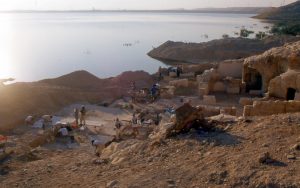Zeugma: a bridge on the Euphrates
Zeugma is hidden among the arid plains that meet the Euphrates River in southeastern Anatolia, Turkey. It is about 40 km from the Syrian border, near the village of Belkis in Gaziantep province.
This place is rich in history and rugged beauty and preserved virtually intact over the centuries. The climate here alternates between extremely hot, dry summers with temperatures as high as 50°C, and cold, snowy winters.
The territory has a predominantly Kurdish population and is mainly cultivated for pistachio nuts; it is only lightly touched by the tourism that fills other regions of Turkey, especially the Mediterranean coast. Only in recent years has Zeugma drawn the attention of the entire world, bringing academics, archaeologists, journalists, politicians and tourists to the site. Interest was raised by the furor surrounding sensational archaeological discoveries and events connected with the state project to exploit the region’s hydro geological resources (called the Great Anatolia Project – GAP), which involved building some ten giant dams on the Tigris and Euphrates, including the Bireçik dam.
Zeugma is the name given to two cities, Apamea and Seleucia, founded on opposite sides of the Euphrates by Seleucus I Nicator (312-281 BC), a Macedonian general under Alexander the Great. The two cities were connected by a bridge, from which they got the name “Zeugma,” or bridge in Greek.
In the first century BC, the two cities passed under Roman control. Legion IV was settled in this region with the job of controlling the only stable crossing of the Euphrates for hundreds of kilometers.
For 200 years the two cities were a vital commercial hub between the Roman and Parthian empires. At the height of its development, Zeugma had between 50,000 and 75,000 inhabitants and the part on the western bank covered more that 2000 hectares of area.
With the weakening of the Roman Empire in the third century AD, the city was sacked and burned (AD 252) by the Sassanids. Zeugma appears the first time in literary sources in AD 1048. Its remains were known only to treasure hunters up to the 19th century and were frequently plundered; in 1970, they were identified for the first time as belonging to the ancient city of Zeugma by the German archaeologist, Jorg Wagner.
In the 1980s and ‘90s, numerous archaeological studies were conducted by the University of Western Australia, the University of La Rochelle and by the Turkish Ministry of Culture, Gaziantep Museum. Only in 1999-2000 did Zeugma become well known and draw the interest of the scientific community and the international press.





















